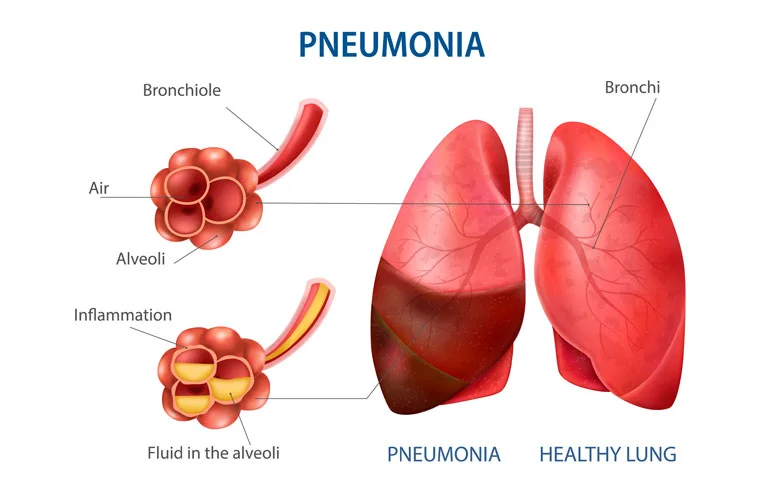- Home
- Departments
Departments Of Pneumonia
Pneumonia-SpecialistPneumonia is an infectious lung disease characterized by inflammation and consolidation of the lung tissue, typically caused by bacteria, viruses, fungi, or other microorganisms. It can affect people of all ages but is most common in young children, older adults, and individuals with weakened immune systems.
Key Features of Pneumonia:
Respiratory Infection: Pneumonia usually begins as a respiratory infection, often following a viral upper respiratory tract infection (such as the common cold) or influenza. Bacteria, particularly Streptococcus pneumoniae, Haemophilus influenzae, and Mycoplasma pneumoniae, are common causes of bacterial pneumonia, while viruses such as influenza, respiratory syncytial virus (RSV), and the novel coronavirus (SARS-CoV-2) can also cause viral pneumonia.
Inflammation and Consolidation: Pneumonia is characterized by inflammation of the alveoli (air sacs) in the lungs, leading to fluid accumulation, consolidation of lung tissue, and impaired gas exchange. This results in symptoms such as cough, fever, chest pain, shortness of breath, and production of phlegm or sputum.
Types of Pneumonia: Pneumonia can be classified based on various factors, including the causative agent, the location where the infection was acquired, and the severity of symptoms. Community-acquired pneumonia (CAP) refers to pneumonia acquired outside of healthcare facilities, while hospital-acquired pneumonia (HAP) occurs in hospitalized patients. Pneumonia can also be classified as typical or atypical based on the clinical presentation and causative agent.
Complications: Pneumonia can lead to a range of complications, particularly in vulnerable populations such as older adults and individuals with underlying health conditions. These complications may include respiratory failure, sepsis, pleural effusion (accumulation of fluid in the pleural cavity), lung abscess, and acute respiratory distress syndrome (ARDS).
Diagnosis and Treatment of Pneumonia:
Diagnosis of pneumonia typically involves a combination of medical history, physical examination, chest X-ray or computed tomography (CT) scan, and laboratory tests (such as blood tests, sputum culture, or respiratory viral panel) to identify the causative agent and assess the severity of the infection.
Treatment of pneumonia depends on the underlying cause, severity of symptoms, and individual patient factors.
Common treatment options include:
Antibiotics: Antibiotic therapy is the mainstay of treatment for bacterial pneumonia and is often initiated empirically based on clinical presentation and severity of illness. The choice of antibiotic depends on the suspected causative agent and local resistance patterns.
Antiviral Medications: Antiviral medications may be prescribed for viral pneumonia caused by influenza or other respiratory viruses. These medications may help reduce the severity and duration of symptoms if initiated early in the course of the infection.
Supportive Care: Supportive measures such as rest, adequate hydration, pain management, and supplemental oxygen therapy may be provided to alleviate symptoms and support recovery.
Hospitalization: Severe cases of pneumonia, particularly those associated with complications or respiratory failure, may require hospitalization for close monitoring, intravenous antibiotics, oxygen therapy, and supportive care.
Overall, pneumonia is a common and potentially serious respiratory infection that requires prompt diagnosis and appropriate treatment to prevent complications and promote recovery. Vaccination, good hygiene practices, and avoiding exposure to known respiratory pathogens are important preventive measures for reducing the risk of pneumonia.

